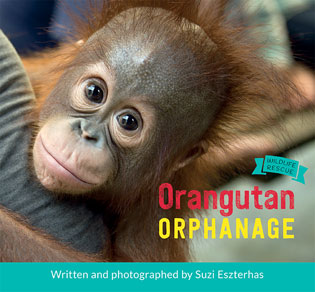| ________________
CM . . .
. Volume XXII Number 32. . . .April 22, 2016
excerpt:
Suzi Eszterhas’ Orangutan Orphanage is the second in the four-part “Wildlife Rescue” series by Owlkids Books. This book follows Koala Hospital, which was released last fall. The new title contains details about the life in an orphanage for orangutan babies before eventually being returned to the wild. The specific orphanage detailed in this book is the Orangutan Foundation International’s Orangutan Care Center and Quarantine. The care center is in Borneo. Readers learn about such things as threats to orangutans by poachers who kill the mothers and steal the babies to sell as pets. Another major threat includes destruction of their habitat. Apparently, the equivalent of three hundred football fields of forest is being cut down every hour in Indonesia. A strength of the book is that, in addition to showing the destructive impact of humans, Orangutan Orphanage also demonstrates the critically important beneficial influence of humans dedicated to the preservation of wildlife. Eszterhas claims that “some of the most amazing moms in the animal kingdom” are orangutan mothers. According to Eszterhas, “they are attentive, loving, and never leave their baby’s side for eight to nine years.” As such, the orphanage care givers have an enormous role in the development and survival of orangutan infants. In addition to bathing and feeding, the foster mothers teach the babies such things as how to climb and which foods are safe to eat. The book design is attractive and engaging. Almost every double-page spread features a full-page, full-colour photograph with a facing page of text and smaller photos. Information is presented in an accessible and logical manner. The writing is succinct, yet informative. The photographs complement the text perfectly. Readers of all ages will enjoy the content and illustrations. The photographs demonstrate the adorable features and uniqueness of each orangutan. We feel Orangutan Orphanage is likely to appeal to children and adults simply because orangutans seem so irresistible. The book contains text features such as a glossary, headings, table of contents, index, and photo captions. As well as facilitating a reader’s understanding, these things can all be used by skillful teachers as a means of introducing children to information literacy and research aids. We believe this book would be great as both a classroom support as well as a recreational read. The “Kids Ask Suzi” question-and-answer section at the end of the book provides further information and will likely provide the answers that some readers want to know. For instance, as we were reading about the endangered nature of orangutans, we wondered how long they typically live. The fact that orangutans in the wild can live to be about fifty years of age was provided within this “Kids Ask Suzi” section. Despite how much we enjoyed the information in the book, there are still unanswered questions. For example, we wonder how long the gestation period is, when orangutans reach reproductive maturity, and how many babies an orangutan might having during its lifespan. These questions seem important in a discussion of an endangered animal. Towards the end of the book, there is also information about how children can help wildlife generally and help orangutans specifically. According to Orangutan Orphanage, “if people don’t do something to protect orangutans soon, they will be extinct in fifteen years.” A portion of the royalties from the sale of this book will be donated to the Orangutan Care Center and Quarantine, run by Orangutan Foundation International, in Borneo. Therefore, by purchasing this book, we can help to provide support for orangutans. It is a worthy cause, and the buyer will be rewarded with a fabulous book. Highly Recommended. Dr. Gregory Bryan is a member of the Faculty of Education at the University of Manitoba. He is a professor of children’s literature and literacy education.
To comment
on this title or this review, send mail to cm@umanitoba.ca.
Copyright © the Manitoba Library Association. Reproduction for personal
use is permitted only if this copyright notice is maintained. Any
other reproduction is prohibited without permission.
Next Review |
Table of Contents for This Issue
- April 22, 2016. |
